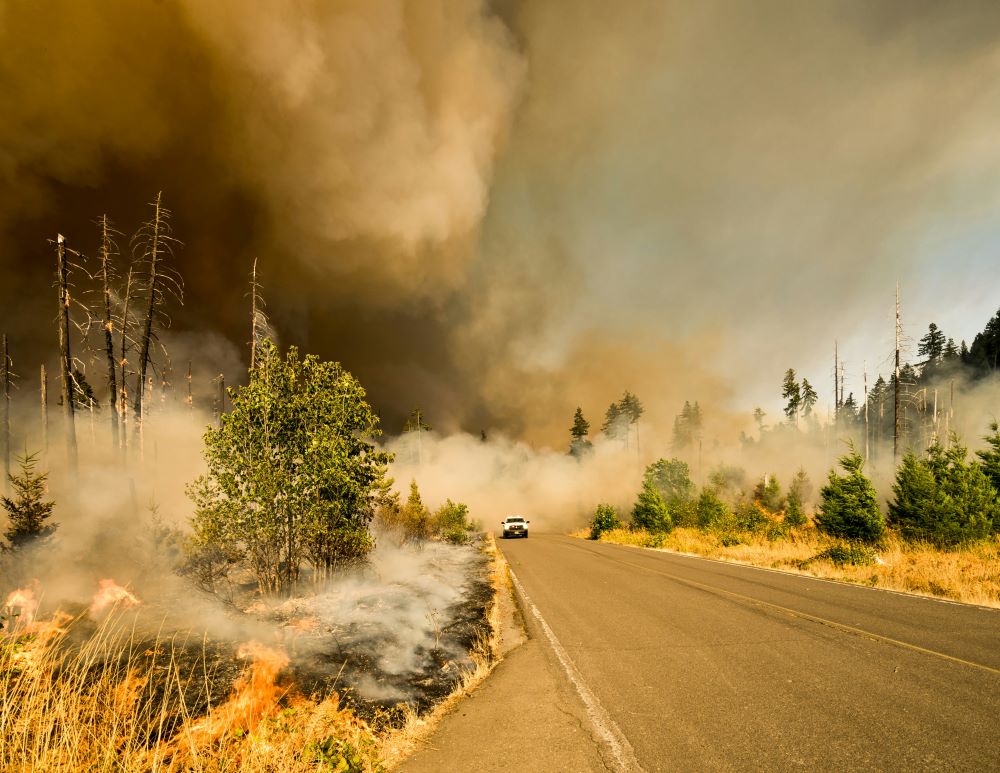Running your Central Air Conditioning in “Wildfire Mode”

Wildfires are scary. We’ve all seen coverage of them on TV, and maybe you’ve seen one in person. The orange or dark skies are foreboding. If you’re not in the immediate path of the fire and you make preparations beforehand, your home can be a refuge. We have one such article on general preparations for wildfires here.
Many homes are already equipped with a system that’s very useful in a wildfire: central air conditioning (or heat), because it has a filter. We’ve been encouraging our clients to utilize it for better air filtration for years, however, it’s a concept that’s still catching on. Thanks to the technology of smart thermostats, scientists were able to analyze data from approximately 4950 California homes during the 2020 wildfire peak and summarize their findings in a study. (Using smart thermostats to reduce indoor exposure to wildfire fine particulate matter (PM2.5)) The data showed that these systems were not effectively utilized for improving air quality.
Smart thermostats are internet-connected, always-on devices that programmatically control residential central air systems. About one third of U.S. houses have a smart thermostat installed today. The data used in the study was voluntarily shared by Ecobee users through the Donate Your Data service and includes parameters such as fan usage, operational modes (heating, cooling, fan only), temperature schedules, indoor and outdoor temperatures, motion detection, and basic metadata about the houses (e.g., age, floor area, number of occupants, and approximate location).
In the study, researchers developed a dynamic mass balance model to estimate air infiltration through the building envelope (Vin), air exfiltration (Vex), mechanical filtration, and particle deposition (Vde). Here is a diagram showing the mass balance:
Source: Using smart thermostats to reduce indoor exposure to wildfire fine particulate matter (PM2.5)
If this diagram seems a bit confusing, it’s just a model to estimate how much of the particulate matter in the outside air during a wildfire comes into the home via infiltration (cracks in the building envelope), and how to best use a central ac or heat system to reduce indoor air particulates. Most homes have plenty of cracks and crevices through which infiltration can take place, but there are forces such as driving winds, stack effect, and exhaust fans that cause negative pressure, which make it worse. Including the ducts in the diagram can estimate how much of the particulate matter is removed by the filter. Basically, what comes into the house (infiltration) equals what goes out of the house (exfiltration) less what is deposited on the floor or on the filter (not taking into account return and supply duct leakage).
Here are some interesting facts about the data:
-
Most homes were situated within 10 kilometers of the meteorological and air quality monitoring stations, so that indoor and outdoor air quality could be compared.
-
Households operated their central air systems for about 5 hours and 30 minutes per day on average in the two peak months of the wildfire season (August and September). Approximately 5 % ran their system constantly and 0.5 % did not operate it at all.
-
The analysis of occupants’ behavioural actions showed that people used their central air systems to control temperature but not air filtration during wildfire events.
-
Results show that simply sheltering indoors (not using any mechanical filtration) reduces exposure to outdoor PM2.5 levels by approximately 75 ± 8 % compared to outdoor exposure. This is due to particles being removed as air flows through building envelope, and are deposited indoors.
-
Baseline air conditioning operation reduces indoor exposure to PM2.5 by 40 ± 5 % compared to simply being indoors without providing air filtration, or 87 ± 5 % compared to outdoor exposure.
-
The wildfire mode operation lowered exposure by an additional 18 ± 5 % compared to baseline air conditioning, 54 ± 5 % compared to no use of the central air system, or 90 ± 5 % compared to outdoor exposure. There was an associated 46 % increase in system runtime (∼5 min/hr) for the wildfire mode over the two-month study period. This would incur an additional energy cost of approximately $75 M for all houses in California, or approximately $5 per month per household.
-
Analysis of the simulation results showed that upgrading from a MERV 10 to MERV 13 filter and implementing the wildfire mode strategy can reduce indoor PM2.5 exposure by 14.6 ± 4 % on average.
-
Large houses, having a low surface to volume ratio, are less impacted by PM2.5 infiltration than smaller homes. The same goes for tightly-sealed houses.
-
Comparing the use of the central system to using portable air cleaners:
-
For typical residential houses in California, upgrading the filter in a central air system from MERV 10 to MERV 13 is as effective in reducing indoor PM2.5 levels as continuously running one portable air cleaner of standard size.
-
More generally, for an average Californian house, using the central air system with a MERV 13 filter results in comparable PM2.5 reductions to using two portable air cleaners.
-
Notably, using the wildfire mode to control a central air system with a MERV 13 translates to a reduction equivalent to four portable air cleaners on average.
-
Health benefits of using the central system:
-
Running the central air system for air conditioning only, reduced the estimated premature mortality by 53 ± 5 % compared to no use of the central air system.
-
The wildfire mode control strategy had an even larger reduction (76 ± 5 %) with an estimated $29 M of monetized benefits of mortality risk reduction.
Wow! “Wildfire Mode” is a big improvement (18.5% less PM2.5 exposure) over letting your central air conditioner “do its thing” or just respond to the thermostat. What is this mode? It’s pretty simple: you just need to add one sensor–indoor PM2.5–and allow a “high PM2.5” signal to automatically turn on the central air system fan, run until PM2.5 drops below another setpoint, and turn off. There are smart thermostats that monitor indoor air quality, compare indoor and outdoor air quality and decide when it’s safe to ventilate, but as far as we are aware, they don’t have a setting that automatically runs the fan when indoor air quality exceeds a preset PM2.5 level. So currently, “Wildfire Mode” is not a thing, but it definitely could be used for more than just wildfires! For example, nearby roadway traffic, duststorms, burning food in the kitchen, nuisance neighbor activity such as smoking, vaping, burning incense or candles, etc.
The other requirement for utilizing your central AC in this way is having the capacity to use a high MERV filter, like MERV 13. MERV 13 is ideal for these type of particulates, but it may cause too much pressure drop if your return air grille/filter size is not large enough. We’ve written several articles on this principle and how to increase the filter area in order increase air filtration; you can start here to check if you have the filter area to upgrade in MERV, then prepare for such an emergency by buying a few extra filters.
When the hazy skies and smoke encroach on your home, it’s time to batten down and execute the plan. Make sure you’re ready to shelter at home!
Photo by Marcus Kauffman on Unsplash






